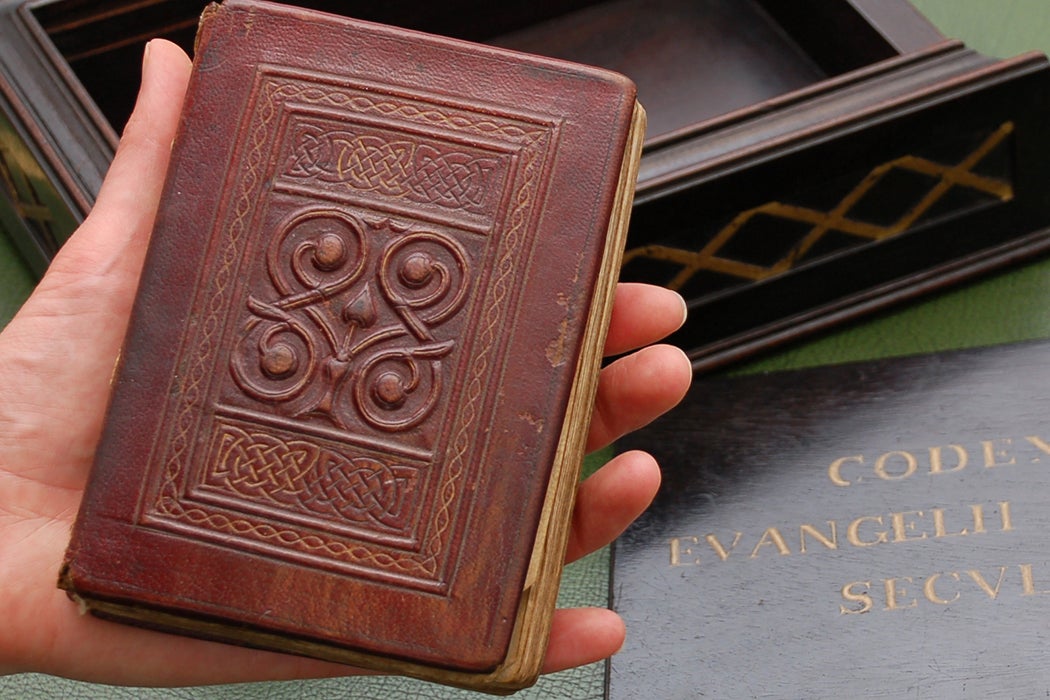 Here is a super cool story from JSTOR (which I’m sure you all follow):
Here is a super cool story from JSTOR (which I’m sure you all follow):
Why Europe’s Oldest Intact Book Was Found in a Saint’s Coffin
The St. Cuthbert Gospel is the earliest surviving intact European book. Some time around 698, it was slipped into the coffin of a saint.Saint Cuthbert’s fame grew following his death in 687. The hermit monk’s body, so the story goes, was found to be incorrupt over a decade after his passing in Northumbria (today’s border between England and Scotland). The miracle led to a cult around his remains. Offerings were placed at his tomb. Some time around 698, a small red book was slipped into his coffin.
This manuscript — known as the St. Cuthbert Gospel, or Stonyhurst Gospel (for Stonyhurst College where it was once held) — is the earliest surviving intact European book. It was removed from Cuthbert’s coffin in 1104, during a transfer of the saint’s remains to a new shrine in Durham Cathedral. “In an eyewitness account of the events surrounding the ceremony of Translation, which took place on Monday, August 29, 1104, [an] anonymous writer describes an investigatory opening of the coffin on the night of Thursday, August 25,” writes historian Calvin B. Kendall in The Journal of English and Germanic Philology. “After examining Cuthbert’s body for evidence of incorruption, the monks reclothed it with costly garments and restored it to the coffin, and ‘As soon as the body of the blessed Father was shut up in the coffin, they covered the coffin itself with linen cloth of a coarse texture, dipped in wax.’”
The book, however, was kept as a separate relic. Today the 1,300-year-old manuscript retains its original pages and binding. It was acquired by the British Library in 2012, and will be on view in the London institution’s Anglo-Saxon Kingdoms: Art, Word, War, opening October 19th. [That settles it. I have to go to London. And there are two exhibits at the National Gallery that I want to see.]
“Its excellent state of preservation can be traced at the outset to the significance it held — a carefully prepared gospel text, which was transferred with the relics of St. Cuthbert to Durham in 1104,” writes scholar Robert D. Stevick in Artibus et Historiae. Because of this remarkable condition, it’s an important example of Insular art, which was created on the British Isles and Ireland between 600 and 900 CE. “There is interlace pattern in two panels on the front cover, step-pattern implying two crosses on the lower cover, a prominent double vine scroll at the center of the front cover—elements of this early art that have been well catalogued for their individual features as well as for their affinities to similar decorative elements in other artifacts,” notes Stevick.


































Fantastic.
And right there, the Last Gospel.
One of the attractions of Durham cathedral (in north-eastern England about 260 miles north of London, but less than three hours by train) is the collection of the relics of St. Cuthbert displayed in the cathedral’s museum. It seems a pity this gospel book isn’t kept there on display with the remains of his coffin and his pectoral cross etc, but I suppose more people will be able to get to see it if it’s on display in London. I’d recommend any visitor to Britain to try to include half a day in Durham: both its cathedral and nearby castle (now part of the city’s university but some of which is open to visitors) are well worth a visit. The American travel writer Bill Bryson described Durham Cathedral is the best one on planet earth and he’s probably right. (He was the Chancellor of the University of Durham for several years and I think he now lives in England.)
I am not an expert but it looks to my untrained eye like the script might not be from England. Was this book produced somewhere else in Europe?
Actually, I believe that capitular uncial script was fairly commonly used in the monastic communities in Northumbia at this time
Interesting how they didn’t write out the name of God. Instead of Deum it’s just “dm” and instead of Deus it’s just “ds”.
What do you call a book addict?
The other great book associated with St. Cuthbert is the Lindisfarne Gospels taken to Durham along with St. Cuthbert’s body after the Viking raids in 875. This marvelously decorated Gospel Book also in insular script contains an interlinear translation of the Latin Gospels into Anglo-Saxon making it the oldest known English rendering of the Gospels.
mepoindexter: Those abbreviations (nomina sacra) were found in almost all manuscripts and printed books well into the 17th century. Even when written in Latin it was not unusual to find the name of Jesus Christ rendered as IHS XPS.
KateD bibliophile
Interesting post and comments. Thanks.